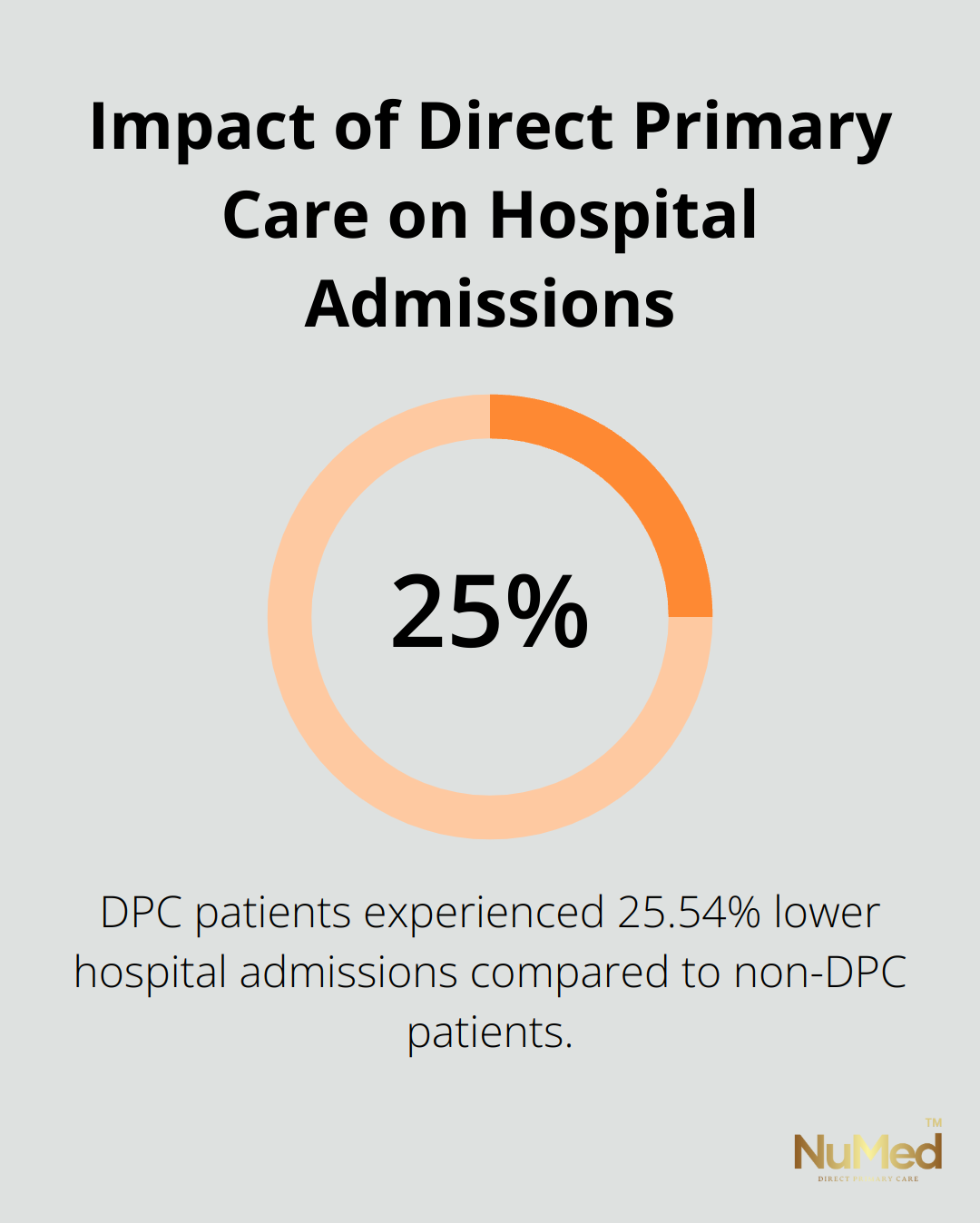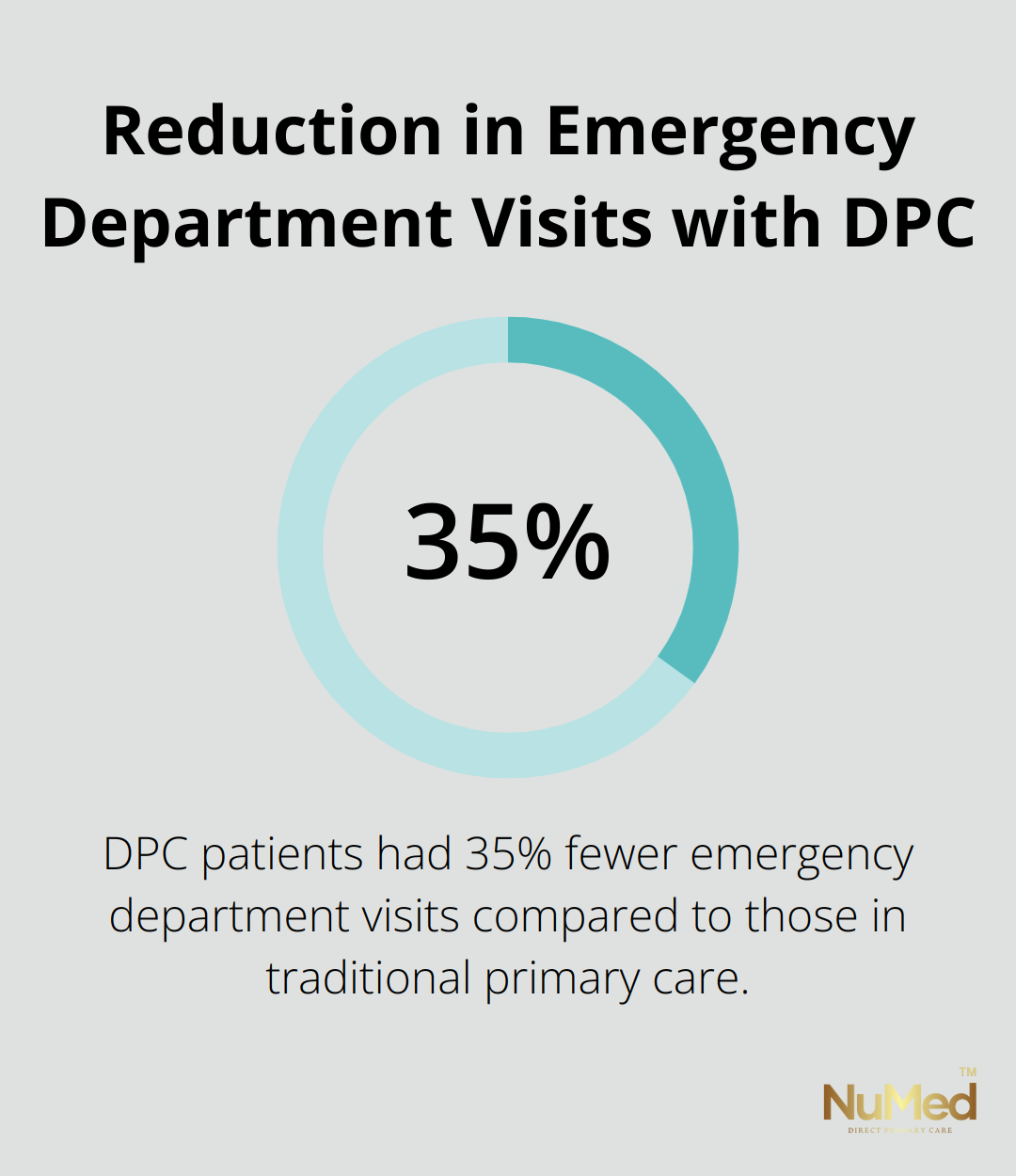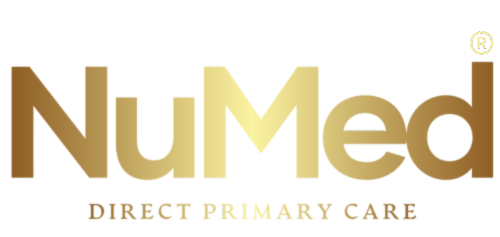At NuMed DPC, we often hear the question: “How much does Direct Primary Care cost?” It’s a crucial consideration for those seeking an alternative to traditional healthcare models.
In this post, we’ll break down the typical costs associated with Direct Primary Care and explore the value it offers patients. We’ll also discuss factors that influence pricing and help you understand the long-term financial benefits of this innovative healthcare approach.
What Is Direct Primary Care?
The Fundamentals of DPC
Direct Primary Care (DPC) revolutionizes healthcare by eliminating insurance companies from the primary care equation. This model creates a direct financial relationship between patients and their primary care providers. DPC operates on a membership-based system where patients pay a monthly or annual fee directly to their healthcare provider.
DPC vs. Traditional Models
DPC stands in stark contrast to traditional insurance-based models. It removes copays, deductibles, and complex billing processes associated with insurance claims. This streamlined approach results in more transparent pricing and often lower overall healthcare costs for patients.
In traditional models, a single office visit might cost $200 or more (not including additional costs for labs or procedures). DPC, on the other hand, typically includes these services in the monthly fee, which ranges from approximately $65 to $150 per month, depending on age and other factors.
The Structure of DPC Costs
DPC’s cost structure is refreshingly simple. Patients pay a recurring fee (usually monthly) that covers a wide range of primary care services, including:
- Unlimited office visits
- Same-day or next-day appointments
- Telemedicine consultations
- Basic lab work and tests
- Some in-office procedures
For services not covered by the monthly fee (such as specialized tests or procedures), DPC practices often offer discounted rates. For example, an MRI that might cost $1,000 or more through traditional insurance channels could be available for $400 or less through a DPC provider’s negotiated rates.
The Financial Impact of DPC
Research indicates that DPC can lead to significant cost savings. Practices that have adopted DPC have reported lower hospital admission rates and emergency room visits, translating to substantial cost savings.
Furthermore, the predictable nature of DPC costs allows patients to budget more effectively for their healthcare expenses. Instead of facing unexpected bills or high deductibles, patients know exactly what they’ll pay each month for their primary care needs.
As we explore the typical cost range for Direct Primary Care in the next section, you’ll gain a clearer understanding of how this innovative model can benefit your health and your wallet.

What Does Direct Primary Care Actually Cost?
Monthly Membership Fees: The Core of DPC Pricing
Direct Primary Care (DPC) offers a straightforward cost structure. The monthly membership fee forms the foundation of DPC pricing. The fee generally ranges from $55 to $150 for adults. Children’s fees are often lower, usually between $10 to $50 per month. These fees cover comprehensive primary care services at a predictable cost.
Additional Costs: Beyond the Basic Membership
While the monthly fee covers most primary care services, some specialized tests or procedures may incur extra charges. However, these costs often undercut traditional insurance channels significantly.
Factors That Influence DPC Pricing
Several elements can affect the cost of DPC services:
- Geographic location: Urban practices may charge more than rural ones due to higher living costs.
- Provider experience: More seasoned physicians might set higher fees.
- Service range: Some practices include a wider array of services in their monthly fee.
- Practice size: Smaller, boutique DPC practices might charge more than larger ones (due to economies of scale).
Despite these variables, DPC often proves more cost-effective than traditional insurance-based models.
The True Value of DPC
When evaluating DPC costs, it’s important to look beyond the monthly fee. Consider the value of included services, potential savings on medications and tests, and improved access to care. Many DPC practices offer transparent pricing lists for any additional services, allowing patients to make informed decisions about their healthcare spending.
The cost-effectiveness of DPC extends beyond immediate savings. The model’s focus on preventive care and easy access to physicians can lead to better health outcomes and reduced long-term healthcare expenses. This approach to healthcare not only saves money but also improves quality of life for many patients. With Direct Primary Care, you receive worry-free care, without copay costs or insurance billing, allowing providers to prioritize and focus on your needs.

Why Direct Primary Care Offers Unmatched Value
Comprehensive Care Without Hidden Costs
Direct Primary Care (DPC) offers many benefits, such as better access to care, personalized attention, and predictable costs. It provides exceptional value for patients who seek comprehensive, accessible, and cost-effective healthcare. DPC membership typically includes a wide array of primary care services. Patients receive unlimited office visits, same-day or next-day appointments, and telemedicine consultations. This comprehensive coverage eliminates the need for copays or unexpected bills. Patients can seek care without financial hesitation.
Many DPC practices also include basic lab work and in-office procedures in their monthly fee. A study by the Society of Actuaries found that DPC patients experienced 25.54% lower hospital admissions compared to non-DPC patients. This reduction in hospitalizations improves patient health and leads to significant cost savings.
Substantial Savings on Out-of-Pocket Expenses
DPC patients often enjoy substantial savings on out-of-pocket expenses. A report from the American Academy of Family Physicians found that DPC practices can reduce healthcare costs by up to 40% compared to traditional models. These savings come from eliminating insurance overhead, reducing unnecessary specialist referrals, and negotiating lower prices for medications and lab tests.
Many DPC practices offer medications at wholesale prices, saving patients up to 95% on prescription costs. Additionally, DPC providers often negotiate discounted rates for imaging services and specialist consultations. They pass these savings directly to their patients.
Time-Saving Access and Improved Health Outcomes
The improved access to care in DPC models translates to significant time savings for patients. With same-day or next-day appointments and direct communication with providers, patients can address health concerns promptly. This quick access potentially prevents more serious (and costly) health issues.
A study published in the Journal of Health Economics found that DPC patients had 35% fewer emergency department visits compared to those in traditional primary care. This reduction saves time and leads to better health outcomes and lower overall healthcare costs.

Focus on Preventive Care
DPC’s focus on preventive care and personalized attention allows for early detection and management of chronic conditions. The American Journal of Managed Care reported that DPC patients with chronic conditions (like diabetes and hypertension) showed improved health markers compared to those in traditional care models.
Personalized Attention
In DPC practices, providers can dedicate more time to each patient. This increased attention allows for more thorough examinations, in-depth discussions about health concerns, and personalized treatment plans. Patients often report higher satisfaction with their care in DPC models due to this individualized approach.
Final Thoughts
Direct Primary Care (DPC) offers a simple cost structure with monthly fees typically ranging from $55 to $150 for adults. This model provides comprehensive primary care services without the complexities of traditional insurance, allowing patients to budget effectively for their healthcare needs. DPC’s emphasis on preventive care and easy physician access can improve health outcomes and reduce long-term healthcare expenses.
When selecting a DPC provider, patients should evaluate the services included, the provider’s experience, and the practice’s communication methods. NuMed Direct Primary Care delivers compassionate, holistic healthcare that addresses the root causes of illness. Our approach combines extensive lab services, functional medicine, and health coaching to create personalized treatment plans.
The true value of DPC extends beyond the monthly fee, encompassing improved health outcomes and potential long-term cost savings. Patients who wonder “How much does Direct Primary Care cost?” should consider not just the price, but the comprehensive approach to care and the investment in a healthier future that DPC represents.
















